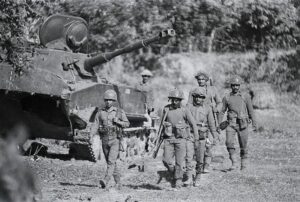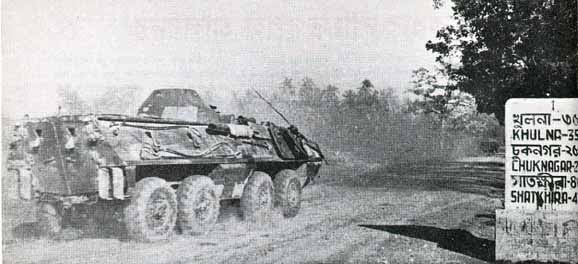Battle tanks are one of the essentials of military forces in frontal ground warfare. Tanks are a symbol of dependence on the battlefield to destroy the opponent. Tanks have been widely used on the battlefield since World War I. Many a time in history each Loha Lakkar tank has left its mark on the pages of history, becoming a legend and an example of valor and valor for generations to come.
But not all the bravery that gets a place in the pages of history. Heroic stories can be erased due to lack of historiography. Generations know about many historical battles and some unimaginable war tactics thanks to Western movies, but many may not know about the historic Shiromani tank battle that took place on the battlefield of ’71. Our strategy is currently taught in military academies of 35 countries. This article is about the battle of Shiromani.
During the Second World War, the British built a strong base in Jessore in anticipation of a Japanese attack. Japanese forces occupied Burma. To keep India under their control, the British built extensive defenses across the eastern region. The defenses of the Jessore base were very strong. Jessore cantonment came under the control of Pakistan after partition. It became a full cantonment in 1958 through a gazette.
In 1971 Jessore Cantonment was commanded by the 107th Brigade of the 9th Infantry Division of the Pak Army. At the beginning of the war, Mukti Bahini managed to liberate Jessore city on 31st March, although the freedom fighters retreated after 6 days under intense shelling by the Pakistani invaders.
By December, Asia’s so-called best forces were in tatters after being beaten by guerillas in almost every part of the country. After forming a joint force with Indian forces, Mukti Bahini planned to liberate one city after another like regular forces in parallel with guerrilla operations.
In 1971, the Eastern Command of the Indian Army was headquartered in Kolkata, which is only 110 km from Jessore. Realizing the importance, the Pak Army had organized a massive army rally in Jessore. Proud of this impregnable base, they called it the ‘Stalingrad of the East’.
The Pak army was sure that a joint attack with Indian forces would come first in Jessore. Benapole-Jesore, Krishnanagar-Darshana-Chwadanga, Murshidabad-Rajapur-Kushtia- they made an impenetrable defense line along these three places. Most of the time, the Pakistanis lined up defense lines centered on the highways leading into major cities. And every time Mukti Bahini proceeded by taking an alternative route, fooling them. In the game of art of war, the Pak forces would have retreated before the war started. Meanwhile, Mukti Bahini reached within 15 km of Jessore cantonment by crossing Boyra and Kapotaksh rivers. From 21st November to 6th December, a terrible battle, known as the Battle of Garibpur, took place here.
On 7th December the Allies advanced to occupy the Jessore base. But they discover an empty base.
Mukti Bahini feared a lot of bloodshed in occupying Jessore base surrounded by strong defense. There was enough weapons to hold off the coalition forces for at least 2 weeks, and all the surrounding areas were supplied with weapons from here. But the Jessore cantonment came under the control of Mukti Bahini almost unchallenged, the coalition forces discovered an abandoned base while liberating Jessore. Pak army retreated. After the defeat at Gharibpur, the morale of the Pak army was broken. It was reported that they retreated and stayed at Shiromani in Khulna. There were 3 reasons for retreating from such a well-equipped system
First, Brigadier Hyatt, the commander of 107 Brigade, assumed that the 7th Fleet would arrive within days and that US Marines and amphibious forces would come and rescue them across the Red River. So it is better to stay near the river.
Second, this industrially advanced location had plenty of room for defensive positions. At the Battle of Stalingrad, when Hitler’s forces were on the outskirts of the city, the Red Army took up defensive positions in every fortified house in the city and successfully repulsed Hitler’s forces. The Pak Army also moved into defensive positions using every fortification
Thirdly, Shiromani was already well known to the invaders and the geographical advantage of this place with several rivers was good.
From December 7-12, Khansena strengthened their position in every house of Shiromani. Eastern Gate, Alim Jute Mill, Ofil Jute Mill, Atra, Gilatala were each converted into forts. Bunkers and minefields were created several yards apart at Mashiati to repel attacks. Pakistanis set up headquarters in cable factories. They did not leave even an inch of area outside the range of their guns.
The strength of Pakistani forces in Shiromani is as follows:
1) 32 Sherman tanks
2) 2t M24 Chaffee Tank (Actual number may be more)
3) 150 Artillery (which Pakistan advertises as 15)
4) 400 commandos
5) Regular infantry (about 5 thousand soldiers)
6) 150 Rajakar
After a few yards on him, Shiromani became impenetrable to bunkers, trenches, minefields, camouflages.

On 10-12th, the joint forces launched one attack after another to occupy the positions of Pak forces in Phultala. As the river Bhairav is crossed, even if it is tried, it is not possible. However, the Pak army was surrounded by strengthening the army in all the surrounding positions.
In fact, the joint forces were temporarily defeated by the tactics of the Pakistan Army till the 12th. The joint forces were repeatedly attacking the screening position (another position in front of the main defense line to deceive the enemy, in which the enemy cannot easily find the main line and the main line can be prepared) thinking the main position of the Pakistan Army. Despite heavy casualties, the Pakistani Army held the screening position.
From the 13th, Shiromani was rocked by shelling. But the position of Pak army could not be harmed. A message was sent asking for air support. For two days, the Indian aircraft bombarded non-stop. After two days, the response of the invaders was completely reduced. The Allies assumed that the Pakistani forces might have retreated or were dying from heavy bombardment, but Mukti Bahini sources and analysis of the battle situation suggested otherwise.
On this day the Rajput regiment came and joined the battle. The Indian Engineering Division constructed a floating bridge over the Bhairav River. Additional freedom fighters came from nearby areas and took up positions in Barrackpore, Siddipasha, Lakohati, Dhulgram.
On the 14th a party under the command of Major Mahendra Singh and Major Gani started marching towards the factory alone, ignoring the views of the Mukti Bahini. A fleet of 28 vehicles fell into an ambush as soon as they entered Badamtala. All 26 vehicles were destroyed. Major Mahendra Singh escaped but 250-300 soldiers were killed. The 107th Brigade was unable to respond to the intense air attack, biting the ground and falling to Shiromani. Eyewitnesses saw truckloads of Indian soldiers carrying away bodies that day.
By the 15th, the Pak forces lost their communications office (Peace President Nurul Huda’s house), at least 4 tanks, Razakar camp, post office (armoury) and a few trucks of ammunition.
On the 15th, the war continued non-stop throughout the day. After heavy casualties, the Allies no longer retained the main command of the war. It was handed over to Major Manzoor (later Brigadier) who commanded the Liberation Army. Major Manzoor took off his waist belt and placed it on the table and bet that he would not return without winning the war. According to some sources, he wrote a letter to his wife. Till date, the joint forces have not been able to show great success, but as a result of several skirmishes, the Pak forces reduced their position and brought it to Shiromani.
Although Niazi surrendered in Dhaka on 16th, Brigadier Hayat decided to continue the war. Major Manzoor planned the all-out war. It was planned to divide into 7 divisions and attack the position of Pak Army from all sides. Due to the horrors of the war, the Indian officers took some distance.
Shiromani’s right Mukti Bahini column under the command of Major Huda was assigned the responsibility of second defense behind. Indian troops on the front line were deployed in defensive positions on the right. 2 left and 3 rear commando columns were brought to the front line. As soon as the signal was received, the two PT 76 tanks that had been lurking under the main road began to advance at full speed. Behind the tank were 12 commandos including Major Manzoor. Another 6 tanks burst through the cane trees on the right and hit the front line of the Pakistani invaders. This group of Mukti Bahini was lost in the fog. Major Huda ordered the second line to advance. Allied artillery attacks began from the rear.
There were 25 tanks in front, several hundred mortars. A few freedom fighters entered the defense line of the Pak army in the midst of firing hundreds of shells. Freedom fighters came out from behind their tanks. Amid intense fire, the driver-gunners climbed on top of the tank and started firing with Stenguns. Grenades are thrown when the hatch is opened. Trees are uprooted in the fire. To his surprise, Brigadier Hyatt discovered that his tank forces on the front line had stalled. Pak army retreated. A Mukti commando came running and reported, “The Khans are running away”. The column of Mukti Bahini started moving forward raising the voice of “JOY BANGLA”. At the same time, the rest of the Allied tanks also came out of defensive positions and began to attack. When the airstrikes started again early in the morning, the Pak Army realized that the front line had collapsed, this time there was no escape from the airstrikes.
On the morning of December 17, some unarmed freedom fighters went to Bisik Road to talk to the Pak Army. By noon, approximately 3,700 Pakistani troops surrendered. Major Manzoor ordered them to remove their badges. Khulna was freed. Pak soldiers continue to berate themselves for their infamy.
According to locals, not a single house was spared within a 4 km area of Bisik Industrial City. According to military experts, no tank, artillery, infantry and hand-to-hand combat took place on the same battlefield since World War II except in Shiromani. This war strategy is taught in the defense colleges of the armies of 35 countries including India, Poland.

